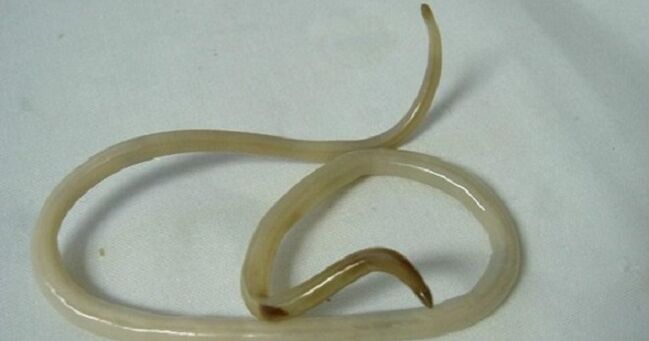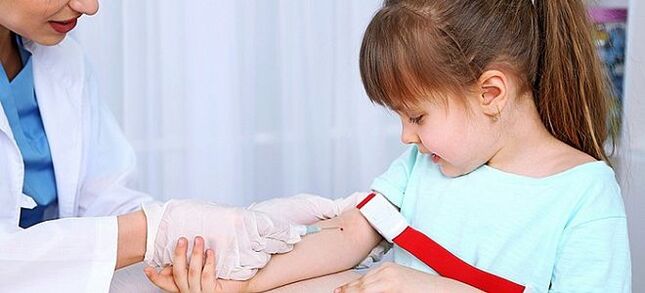
Anyone can get parasites, but babies are particularly affected and the risk is particularly high in summer. There are different types of worms, but all of them have a negative effect on health. Parents should know what worms are in children - we will consider the symptoms and treatment of a disease such as helminthiasis below.
Types of worms in humans
There are 12, 000 worms (they are also called helminths) on our planet. They live in soil, food and animals, while around 200 species can live in the human body. Parasites always need a host and often choose babies for their habitat. As a child learns the world, they taste everything they can get their hands on, so they are constantly at risk.
The most common types of worms in children are nematodes, or roundworms. These include:
- roundwormcause ascariasis. Helminths are large and can reach 40 cm in length, they parasitize in the gastrointestinal tract and small intestine.
- pinwormscause enterobiosis. The worms are small (less than 1 cm long) and whitish-yellow in color. Such helminths live in children in the cecum or small intestine. Their life cycle is up to 4 weeks.
- cestodoses- These are tape flatworms that parasitize in the intestines and various organs. Helminths cause diseases such as teniosis, echinococcosis, hymenolepiasis, teniarinhoz and diphyllobothriasis.
- trematodosare flatworms or trematodes. These include cat flukes, paradoxical leukochloridium, schistosome. Parasites provoke such diseases as fascioliasis and opisthorchiasis.
Routes of infection with worms
According to official medical statistics, worms occur in children under 2 years old and in preschool children attending educational institutions in 80% of cases. These official numbers are registered with the babies who have undergone laboratory tests. Helminths use all possible routes to enter the human body. The most common routes of infection are:
- dirty hands or contact with infected animals;
- poorly washed fruits or vegetables;
- raw water;
- poorly processed fish or meat.
How to understand that the child has worms?
To answer the question of what are worms in children (the symptoms and treatment depend on the type of helminth), you need to know how the infection occurred and what internal organ the parasites got into. Very often they do not manifest themselves in any way, and the disease proceeds in a latent form, so the doctor cannot always determine their presence. Helminths live in the human body for years and even decades, they adapt to the most adverse conditions.
Common signs of worms in children can be as follows:
- morning sickness;
- anal itching;
- Headache;
- Bruxism - is the grinding of teeth in a dream;
- profuse salivation at night;
- Dizziness;
- nasal polyps;
- inflammation of the genitals;
- periodic pains around the navel;
- sheep droppings, diarrhea or constipation;
- loss of appetite;
- pallor of the skin.
If you find more than five of the listed symptoms in your child, it makes sense to suggest a helminth invasion. Each person can be a carrier of various helminths, which parasitize in the body and lead to poisoning and serious diseases. With the activation of parasites, the signs can change. If you suspect worms in children, the symptoms can also appear externally:
- "chicks" (rashes) on the thighs or forearms;
- bruises and dark circles under the eyes;
- early tooth decay;
- lack of body weight;
- brittleness of nails and hair;
- growth failure;
- allergic reaction.
Worms in children can affect the nervous system:
- babies become irritable;
- concentration of attention decreases;
- stamina is lost;
- sleep is disturbed.
What do worms look like in a child's stool?
Young parents are very often interested in the question of how to identify worms in a child's feces. In fact, only large worms can be seen in children's feces. Parasites leave the body in clumps in which there are few individuals. If you see foreign inclusions, it is better to contact a specialist and have tests done to rule out the presence of parasites.
Tests for worms in children
If parents suspect worms in children, symptoms and treatment depend on the stage of the disease. To make the diagnosis, you need to take the child to a gastroenterologist or pediatrician. The doctor conducts an initial examination and prescribes an examination, which includes:

- Enzyme immunoassay - helps to identify the type of worm and its presence, for this, blood is taken from a vein from the child on an empty stomach;
- a blood test for helminths in a child - the main indicators are: the number of eosinophils, the presence of anemia and a color indicator;
- cockroaches, smear for enterobiasis - taken from the anus;
- a general analysis of feces for eggs and dysbacteriosis is carried out in 3 stages, since some types of worms do not lay eggs regularly;
- Computed tomography, radiography or ultrasound examination - are carried out to determine the presence of worms in the human body.
The child has worms - what to do?
After the diagnosis is confirmed, the doctor prescribes the treatment of worms in children, the drugs should be strictly coordinated with the doctor), talks about folk methods and products that should be used for a speedy recovery. Parents should know that it is impossible to give medicines to babies on their own, as this can lead to irreversible consequences, thereby worsening the child's condition.
If you do not know how to get rid of worms in children, contact a specialist who will write you several stages of therapy. They include:
- Preparation of the body - in this case, sorbents and antihistamines are prescribed;
- anthelmintic therapy - traditional drugs against parasites, which can be in the form of tablets, suppositories or suspensions;
- Cleansing the body - enemas, choleretic drugs or sorbents.
Treatment of worms in children is carried out at home, if there are no complications in the form of infectious lesions. All the time the child must follow a special diet. After the first therapy, the child is examined and tested again. If they again show the presence of parasites in the body, the drugs are prescribed again.
Tablets from worms for children
Currently, there are several drugs that help get rid of worms. They are available in tablet form and are intended for babies. Consultation with a specialist is required before use.
Suspension of worms for children
If your child is still small and does not know how to drink pills, then specially designed suspensions are suitable for him.
Folk remedies for worms in children
It is impossible to completely get rid of parasites with the help of traditional medicine, but you can increase immunity and speed up treatment. A remedy for children's worms should be taken with caution and only with the permission of a doctor. The most popular products are:
- Garlic;
- pumpkin seeds;
- carrot juice;
- vegetable fat;
- Infusions of celandine and wormwood or tansy.
Prevention of worms in children
All parents should know that for prevention, children can be given deworming tablets to create a special microflora in which helminths simply cannot exist.
In order not to get infected with parasites, you must:
- Observe the rules of personal hygiene.
- Wash your hands with soap and water after using the toilet and walking.
- fight flies.
- Keep pacifiers and toys clean.
- Iron clothes and linen.
- Be careful with food.
Depending on the age of the baby, there is a difference in the prevention of worms in children, drugs are given only from 6 months.
























